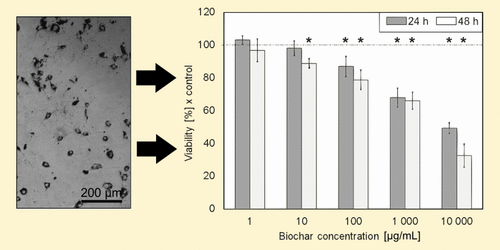当前位置:
X-MOL 学术
›
Environ. Sci. Technol. Lett.
›
论文详情
Our official English website, www.x-mol.net, welcomes your feedback! (Note: you will need to create a separate account there.)
Cytotoxicity of Biochar: A Workplace Safety Concern?
Environmental Science & Technology Letters ( IF 10.9 ) Pub Date : 2017-08-08 00:00:00 , DOI: 10.1021/acs.estlett.7b00267 Gabriel Sigmund 1 , Daniela Huber 2 , Thomas D. Bucheli 3 , Martina Baumann 4, 5 , Nicole Borth 4, 5 , Georg M. Guebitz 2, 5 , Thilo Hofmann 1
Environmental Science & Technology Letters ( IF 10.9 ) Pub Date : 2017-08-08 00:00:00 , DOI: 10.1021/acs.estlett.7b00267 Gabriel Sigmund 1 , Daniela Huber 2 , Thomas D. Bucheli 3 , Martina Baumann 4, 5 , Nicole Borth 4, 5 , Georg M. Guebitz 2, 5 , Thilo Hofmann 1
Affiliation

|
Biochar has a number of environmental applications, including soil amendment for agriculture, remediation of contaminated soils and sediments, and climate change mitigation. Dust formed during its production and field application may pose a health risk, but the cytotoxicity of biochar has, to the best of our knowledge, not previously been investigated. Therefore, we measured the concentration-dependent cytotoxicity of biochar on an NIH 3T3 mouse fibroblast cell line. We used a contaminant trap experiment to measure the total and nondesorbable polycyclic aromatic hydrocarbon (PAH) fractions of the biochar. PAH release was found to be negligible because of the biochar’s strong PAH sorption potential. The biochar was nevertheless observed to have a cytotoxic effect on the fibroblast cells; the EC10 values were 49.6 and 18.8 μg/mL after incubation for 24 and 48 h, respectively. This cytotoxic effect is likely to relate to the particulate nature and size distribution of the biochar; the biochar had particles similar in size to atmospheric particulate matter (PM2.5) that bound to the fibroblast cell surface. To minimize the risk of exposure, practitioners should wear respiratory protective equipment during biochar production. During field application, biochar should be applied in slurries and should always be mixed with a soil matrix to avoid secondary dust formation.
中文翻译:

生物炭的细胞毒性:工作场所安全问题吗?
生物炭具有许多环境应用,包括用于农业的土壤改良剂,受污染的土壤和沉积物的修复以及缓解气候变化。在其生产和现场应用过程中形成的粉尘可能会危害健康,但是就我们所知,生物炭的细胞毒性尚未得到过调查。因此,我们在NIH 3T3小鼠成纤维细胞系上测量了生物炭的浓度依赖性细胞毒性。我们使用污染物捕集器实验来测量生物炭中总和不可解吸的多环芳烃(PAH)馏分。由于生物炭具有很强的PAH吸附潜力,因此发现PAH的释放可以忽略不计。然而,观察到生物炭对成纤维细胞具有细胞毒性作用。EC 10温育24小时和48小时后,该值分别为49.6和18.8μg/ mL。这种细胞毒性作用可能与生物炭的颗粒性质和大小分布有关。生物炭的颗粒大小类似于与成纤维细胞表面结合的大气颗粒物(PM2.5)。为了最大程度地减少暴露的风险,从业人员在生产生物炭时应穿戴呼吸防护设备。在田间施用时,应将生物炭应用于浆液中,并应始终与土壤基质混合,以免形成二次粉尘。
更新日期:2017-08-09
中文翻译:

生物炭的细胞毒性:工作场所安全问题吗?
生物炭具有许多环境应用,包括用于农业的土壤改良剂,受污染的土壤和沉积物的修复以及缓解气候变化。在其生产和现场应用过程中形成的粉尘可能会危害健康,但是就我们所知,生物炭的细胞毒性尚未得到过调查。因此,我们在NIH 3T3小鼠成纤维细胞系上测量了生物炭的浓度依赖性细胞毒性。我们使用污染物捕集器实验来测量生物炭中总和不可解吸的多环芳烃(PAH)馏分。由于生物炭具有很强的PAH吸附潜力,因此发现PAH的释放可以忽略不计。然而,观察到生物炭对成纤维细胞具有细胞毒性作用。EC 10温育24小时和48小时后,该值分别为49.6和18.8μg/ mL。这种细胞毒性作用可能与生物炭的颗粒性质和大小分布有关。生物炭的颗粒大小类似于与成纤维细胞表面结合的大气颗粒物(PM2.5)。为了最大程度地减少暴露的风险,从业人员在生产生物炭时应穿戴呼吸防护设备。在田间施用时,应将生物炭应用于浆液中,并应始终与土壤基质混合,以免形成二次粉尘。


























 京公网安备 11010802027423号
京公网安备 11010802027423号